Welcome to DU!
The truly grassroots left-of-center political community where regular people, not algorithms, drive the discussions and set the standards.
Join the community:
Create a free account
Support DU (and get rid of ads!):
Become a Star Member
Latest Breaking News
General Discussion
The DU Lounge
All Forums
Issue Forums
Culture Forums
Alliance Forums
Region Forums
Support Forums
Help & Search
Celerity
Celerity's Journal
Celerity's Journal
September 24, 2022
Wire – Go Ahead
Label: Harvest – HAR 5192
Format:
Vinyl, 7", 45 RPM, Single, Push-out Center
Country: UK
Released: 2 Nov 1979
Genre: Electronic, Rock
Style: Art Rock, Punk, Experimental





Wire - Map Ref. 41N 93W
Wire – Map Ref. 41ºN 93ºWWire – Go Ahead
Label: Harvest – HAR 5192
Format:
Vinyl, 7", 45 RPM, Single, Push-out Center
Country: UK
Released: 2 Nov 1979
Genre: Electronic, Rock
Style: Art Rock, Punk, Experimental





September 24, 2022
https://www.thrillist.com/drink/nation/how-to-make-a-chicha-morada-cocktail-recipe

Every time my family from Peru visits us in Puerto Rico, I get excited about all of my favorite Peruvian drinks and snacks like chicha morada. If you know, you know. But if you don’t know, this ancient drink is basically Peruvian’s second blood. If you visit Peru, there’s no way you’re going to miss this purple drink because it is served at any kind of restaurant around the country and street vendors, too. You can find it in different varieties–natural or artificial– depending on where you get it. But what exactly is this drink made of and where does it come from?
The Real Academia Española (RAE) describes chicha as “an alcoholic beverage resulting from the fermentation of corn in sugar water, served in various countries in America.” It was used as a medicine prior to the Incan Empire and later consumed to celebrate their ceremonies. But chicha morada is one of the varieties of non-alcoholic chichas served around Peru. Although it’s not a fermented drink, according to researcher Sergio Zapata Acha’s book Dictionary of Traditional Peruvian Gastronomy, it was a slightly fermented beverage at one point in time.
Now chicha morada is a beverage generally made with boiled purple corn, pineapple skin, red apples, cinnamon, and cloves. Once filtered, sugar and lemon juice are added before serving. The result is basically an agua fresca that is equally refreshing and a cozy drink that can be paired with any dish and even served as an alcoholic cocktail — like a chicha morada pisco sour.
Purple corn comes from the Andean region of Peru and it is responsible for the famous deep purple hue that makes chicha morada visually stunning. Although this ingredient doesn’t necessarily enhance the flavor of the drink, studies have shown that the corn’s pigment acts like an antioxidant that could help to reduce the risk of cholesterol, high sugar levels, inflammation, and more.
snip

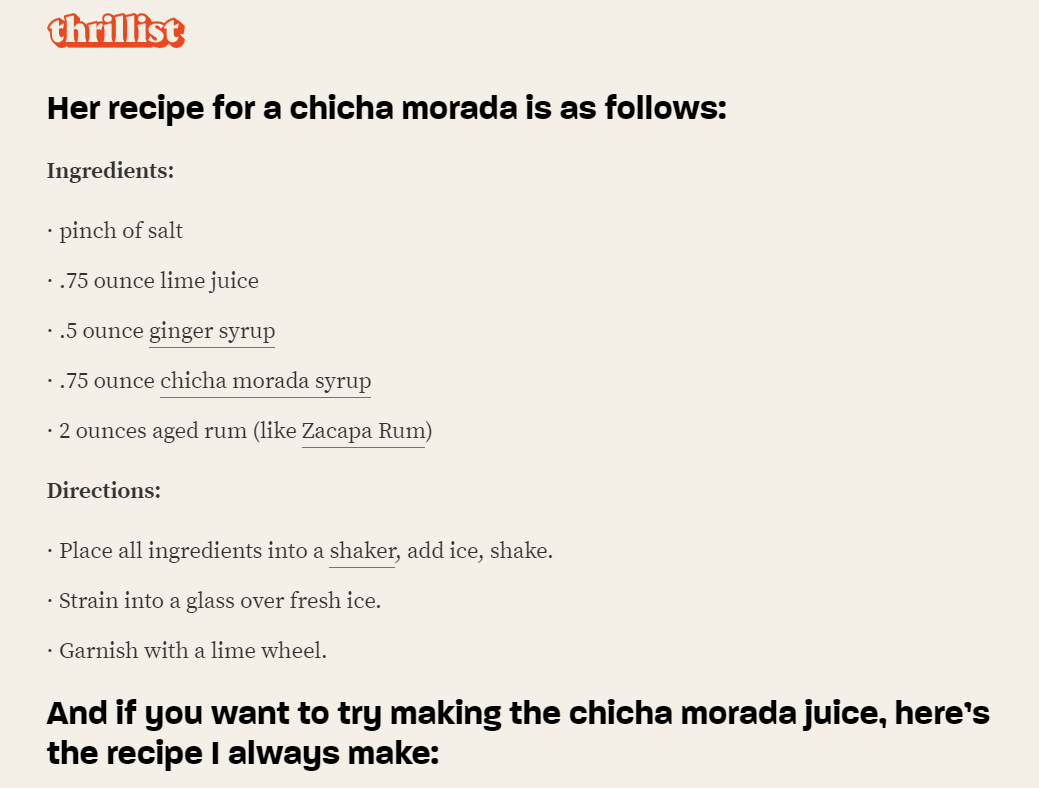
snip
Weekend Project: How To Make Your Own Chicha Morada Cocktail
This Peruvian purple corn drink is perfect for the holiday season.https://www.thrillist.com/drink/nation/how-to-make-a-chicha-morada-cocktail-recipe

Every time my family from Peru visits us in Puerto Rico, I get excited about all of my favorite Peruvian drinks and snacks like chicha morada. If you know, you know. But if you don’t know, this ancient drink is basically Peruvian’s second blood. If you visit Peru, there’s no way you’re going to miss this purple drink because it is served at any kind of restaurant around the country and street vendors, too. You can find it in different varieties–natural or artificial– depending on where you get it. But what exactly is this drink made of and where does it come from?
The Real Academia Española (RAE) describes chicha as “an alcoholic beverage resulting from the fermentation of corn in sugar water, served in various countries in America.” It was used as a medicine prior to the Incan Empire and later consumed to celebrate their ceremonies. But chicha morada is one of the varieties of non-alcoholic chichas served around Peru. Although it’s not a fermented drink, according to researcher Sergio Zapata Acha’s book Dictionary of Traditional Peruvian Gastronomy, it was a slightly fermented beverage at one point in time.
Now chicha morada is a beverage generally made with boiled purple corn, pineapple skin, red apples, cinnamon, and cloves. Once filtered, sugar and lemon juice are added before serving. The result is basically an agua fresca that is equally refreshing and a cozy drink that can be paired with any dish and even served as an alcoholic cocktail — like a chicha morada pisco sour.
Purple corn comes from the Andean region of Peru and it is responsible for the famous deep purple hue that makes chicha morada visually stunning. Although this ingredient doesn’t necessarily enhance the flavor of the drink, studies have shown that the corn’s pigment acts like an antioxidant that could help to reduce the risk of cholesterol, high sugar levels, inflammation, and more.
snip


snip
September 24, 2022

Images of Florida
https://thebaffler.com/latest/the-infinite-previous-hofmann


THE SOUTHERNMOST OF THE CONTINENTAL UNITED STATES, the so-called Lower Forty-eight. Where better shoot for space, publicly or now privately, than from the flattest and lowest and most unstable of them all, its highest point barely a hundred yards up in the soggy air? A plump peninsular dangle haunted by the promise of its physical (dis)appearance decades hence, or, the way things are going, sooner than that—shrunk to bone (it has no bone, there is no bone), hence merely atrophied and shortened to a carious stumpy shrivel or wizen, ending at maybe Orlando, all the rest taken back by the Atlantic and the Gulf. And presumably still impeccably gerrymandered. Well, easy come, easy go, as is not—but might as well be—the state’s motto (which, if you must know, is “In God We Trust”).
From the air, it is cities, bays, jungle, and mottling—what the booksellers call foxing—like a form of rot; a level scape of little mushrooms on blotting paper; a pointillist blotch; the dotting of millions or billions of lakes and ponds among the slabs of forest and field and just swampy spare ground waiting to appreciate; the round clumps of “tree islands,” sometimes called “hammocks” in the palmetto and vine scrub; sinkholes as much a possibility as mobile homes, like the holes in Swiss cheese, sinkholes popping up—popping down—in the porous limestone when the sand plugging them abruptly drains out of them. Gridded by highways meeting at infinity, and then the plops of the round ponds. Round and straight, round and straight, like so many noughts and crosses. Inadequate separation of earth and water, the world as if God had thrown in the towel after Day Two. (And when it teems with bouncing white rain, Day One.) Brown when wet, tan when dry, gray when grown over by the duopoly of pines and palms. Dark wiggling meanders (where is the gradient that would straighten them out or speed them up?), the color of tea from the amount of leaf matter swilled out of the sandy ground, and old white dead straight—no, not authors—roads, silver in the sun, made from sand or crushed shells.

Water is a constant—or rather, an inconstant—mystery, our own prairie that half the time is a lake (we think of it as something like Zola’s Le ventre de Paris, a frenzied frog-eat-frog mutual gourmandize among water-, earth-, and air-creatures); water filling up the underground limestone caverns and spilling out of them at great pressure and purity in the springs of the Santa Fe and the Suwanee (the rights to extract and bottle billions of gallons of it obtained for a pittance by Coca Cola and others), and disappearing to leave behind aridity, sand, and death. So flat, so soft, so rootless, so yielding, so accommodating to invasives and (some) incomers, the pet boa constrictor unspooling out of the toilet, the armadillo hoofing it up from Texas at the rate of a few yards a year, the Cuban migrant crawling ashore, wet-foot or dry-foot, the armed and dangerous jail-break making a beeline for us, the totemic beasts we are known for and are sentimentally pleased to slap on our license plates—the Florida panther, the manatee—imperiled and all-but-gone; a landscape formed by bulldozer as by butter knife from the flat, resistless, featureless plain; no hill, no rock, no soil, slash pines cleared into heaps and middens to make space for new condo developments, with natural or British-sounding or misspelt tony names (the flamingoes or magnolias that were driven away to make this), where an influx of disappointed new or hopeful old people can dwell in brief comfort in system-built high-rise among the low-rise, cheek by jowl with their cars.
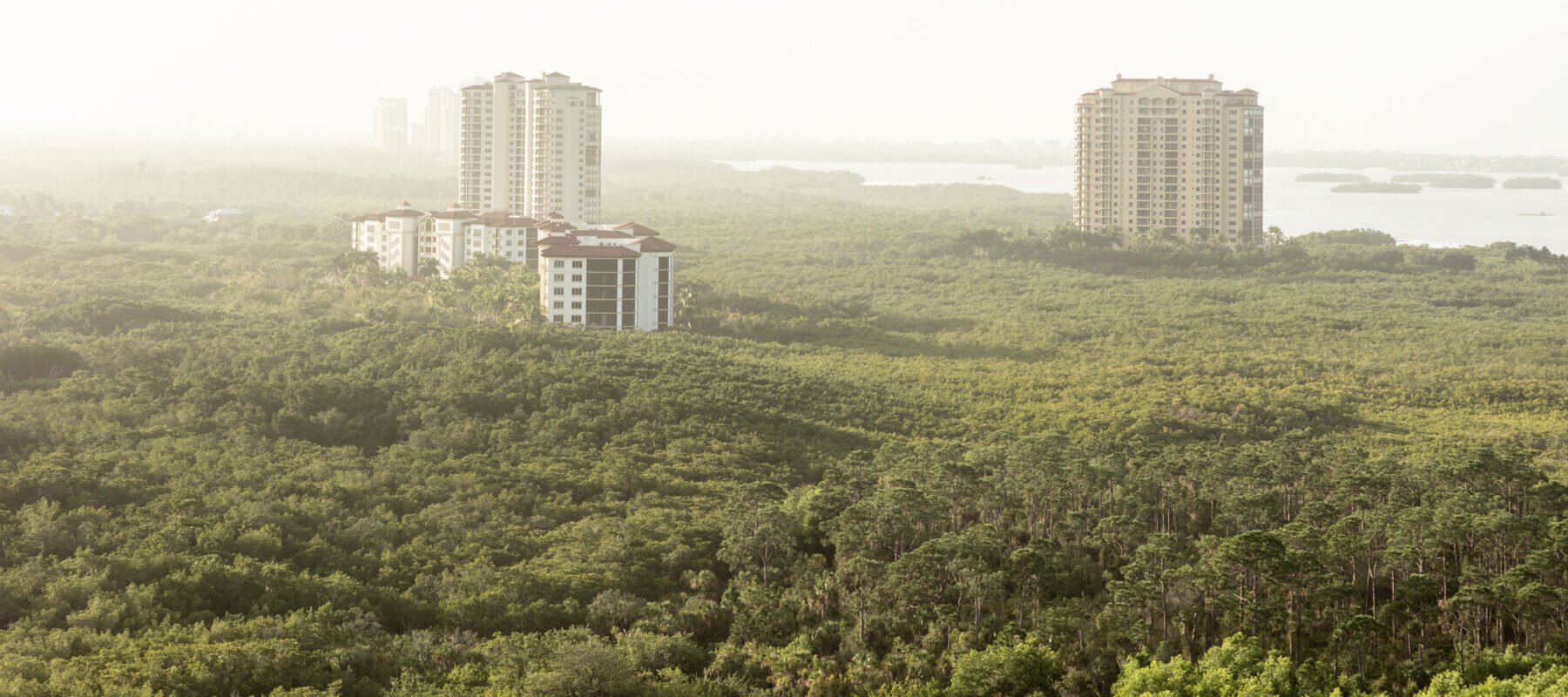
We are perhaps used to thinking of the clash of nature and culture; in Florida, there is no culture, no landscape that leaves a stable record of the effects of human settlement. It is more garish, more conflictual than that, more primal or more modern. It is the clash of nature and money. Subtropical nature and hot money, at that, or at the very least, warm, humid, sweaty money. Pecunia maybe doesn’t olet, but it sudet. The waves of greed and panic, panic buying, panic selling, the land booms and real estate busts, remote ownership, in-your-face ownership; railway barons and cattle barons and trumpery barons; the South a more troubled, less idyllic, less familiar, less idealized version of the West, at best, it’s “go South, old man,” or “Florida and bust!” A less favored version of California, without the rich farmland of Central Valley or the corn of Hollywood or a swamp to call Silicon; a state where things somehow didn’t take as well or as dependably, second in cattle, second in oranges, Florida permanently prox. acc., (though for all our other curses, we don’t have earthquakes; they have the Big One, we have lots of Little Ones, not earthquakes, but all manner of other plagues and pestilences).
snip
my own adds





The Infinite Previous: Florida
cross posting because I find this to be one of the best short pieces on an American state that I have read
Images of Florida
https://thebaffler.com/latest/the-infinite-previous-hofmann


THE SOUTHERNMOST OF THE CONTINENTAL UNITED STATES, the so-called Lower Forty-eight. Where better shoot for space, publicly or now privately, than from the flattest and lowest and most unstable of them all, its highest point barely a hundred yards up in the soggy air? A plump peninsular dangle haunted by the promise of its physical (dis)appearance decades hence, or, the way things are going, sooner than that—shrunk to bone (it has no bone, there is no bone), hence merely atrophied and shortened to a carious stumpy shrivel or wizen, ending at maybe Orlando, all the rest taken back by the Atlantic and the Gulf. And presumably still impeccably gerrymandered. Well, easy come, easy go, as is not—but might as well be—the state’s motto (which, if you must know, is “In God We Trust”).
From the air, it is cities, bays, jungle, and mottling—what the booksellers call foxing—like a form of rot; a level scape of little mushrooms on blotting paper; a pointillist blotch; the dotting of millions or billions of lakes and ponds among the slabs of forest and field and just swampy spare ground waiting to appreciate; the round clumps of “tree islands,” sometimes called “hammocks” in the palmetto and vine scrub; sinkholes as much a possibility as mobile homes, like the holes in Swiss cheese, sinkholes popping up—popping down—in the porous limestone when the sand plugging them abruptly drains out of them. Gridded by highways meeting at infinity, and then the plops of the round ponds. Round and straight, round and straight, like so many noughts and crosses. Inadequate separation of earth and water, the world as if God had thrown in the towel after Day Two. (And when it teems with bouncing white rain, Day One.) Brown when wet, tan when dry, gray when grown over by the duopoly of pines and palms. Dark wiggling meanders (where is the gradient that would straighten them out or speed them up?), the color of tea from the amount of leaf matter swilled out of the sandy ground, and old white dead straight—no, not authors—roads, silver in the sun, made from sand or crushed shells.

Water is a constant—or rather, an inconstant—mystery, our own prairie that half the time is a lake (we think of it as something like Zola’s Le ventre de Paris, a frenzied frog-eat-frog mutual gourmandize among water-, earth-, and air-creatures); water filling up the underground limestone caverns and spilling out of them at great pressure and purity in the springs of the Santa Fe and the Suwanee (the rights to extract and bottle billions of gallons of it obtained for a pittance by Coca Cola and others), and disappearing to leave behind aridity, sand, and death. So flat, so soft, so rootless, so yielding, so accommodating to invasives and (some) incomers, the pet boa constrictor unspooling out of the toilet, the armadillo hoofing it up from Texas at the rate of a few yards a year, the Cuban migrant crawling ashore, wet-foot or dry-foot, the armed and dangerous jail-break making a beeline for us, the totemic beasts we are known for and are sentimentally pleased to slap on our license plates—the Florida panther, the manatee—imperiled and all-but-gone; a landscape formed by bulldozer as by butter knife from the flat, resistless, featureless plain; no hill, no rock, no soil, slash pines cleared into heaps and middens to make space for new condo developments, with natural or British-sounding or misspelt tony names (the flamingoes or magnolias that were driven away to make this), where an influx of disappointed new or hopeful old people can dwell in brief comfort in system-built high-rise among the low-rise, cheek by jowl with their cars.

We are perhaps used to thinking of the clash of nature and culture; in Florida, there is no culture, no landscape that leaves a stable record of the effects of human settlement. It is more garish, more conflictual than that, more primal or more modern. It is the clash of nature and money. Subtropical nature and hot money, at that, or at the very least, warm, humid, sweaty money. Pecunia maybe doesn’t olet, but it sudet. The waves of greed and panic, panic buying, panic selling, the land booms and real estate busts, remote ownership, in-your-face ownership; railway barons and cattle barons and trumpery barons; the South a more troubled, less idyllic, less familiar, less idealized version of the West, at best, it’s “go South, old man,” or “Florida and bust!” A less favored version of California, without the rich farmland of Central Valley or the corn of Hollywood or a swamp to call Silicon; a state where things somehow didn’t take as well or as dependably, second in cattle, second in oranges, Florida permanently prox. acc., (though for all our other curses, we don’t have earthquakes; they have the Big One, we have lots of Little Ones, not earthquakes, but all manner of other plagues and pestilences).
snip
my own adds





September 24, 2022
https://www.thedailybeast.com/as-bad-as-the-world-looks-right-now-its-actually-worse

The annual meeting of the United Nations General Assembly (UNGA) in New York is generally reviled by New Yorkers for the traffic jams it causes, but otherwise ignored by the public at large. One by one, heads of state typically give speeches that cause their staffs great anxiety but, for the most part—laden as they are with idealistic platitudes about the promise of the UN’s mission—disappear quickly into each day’s ocean of news never to be heard from again.
The UNGA occasionally produces a rare newsworthy moment, but even then the 30 seconds of impact it makes on the consciousness of readers and viewers is typically immediately overshadowed—as has been the case this week in the U.S. with domestic political scandals and the appearance of the latest Kardashian baby.
Perhaps it is just as well. Because if the average person paid closer attention to what was really being discussed at the UN, or had the opportunity to listen in on some of the behind-the-scenes conversations as some of us are obligated to do, they would come away from the experience shaken not stirred.
Take for example, Tuesday’s opening speech by UN Secretary-General Antonio Guterres. “We are gridlocked in colossal global dysfunction,” he said, apparently in no mood for bland diplospeak, “The international community is not ready or willing to tackle the big dramatic challenges of our age. These crises threaten the very future of humanity and the fate of our planet. Our world is in peril—and paralyzed.” His core point: “Our world is in big trouble.”

UN Secretary-General António Guterres speaks during a United Nations Security Council.
snip
David Rothkopf: As Bad as the World Looks Right Now, It's Actually Worse
The UN’s General Assembly this week only underscored how much this planet is in crisis—from war to backsliding democracy to climate disaster.https://www.thedailybeast.com/as-bad-as-the-world-looks-right-now-its-actually-worse

The annual meeting of the United Nations General Assembly (UNGA) in New York is generally reviled by New Yorkers for the traffic jams it causes, but otherwise ignored by the public at large. One by one, heads of state typically give speeches that cause their staffs great anxiety but, for the most part—laden as they are with idealistic platitudes about the promise of the UN’s mission—disappear quickly into each day’s ocean of news never to be heard from again.
The UNGA occasionally produces a rare newsworthy moment, but even then the 30 seconds of impact it makes on the consciousness of readers and viewers is typically immediately overshadowed—as has been the case this week in the U.S. with domestic political scandals and the appearance of the latest Kardashian baby.
Perhaps it is just as well. Because if the average person paid closer attention to what was really being discussed at the UN, or had the opportunity to listen in on some of the behind-the-scenes conversations as some of us are obligated to do, they would come away from the experience shaken not stirred.
Take for example, Tuesday’s opening speech by UN Secretary-General Antonio Guterres. “We are gridlocked in colossal global dysfunction,” he said, apparently in no mood for bland diplospeak, “The international community is not ready or willing to tackle the big dramatic challenges of our age. These crises threaten the very future of humanity and the fate of our planet. Our world is in peril—and paralyzed.” His core point: “Our world is in big trouble.”

UN Secretary-General António Guterres speaks during a United Nations Security Council.
snip
September 24, 2022
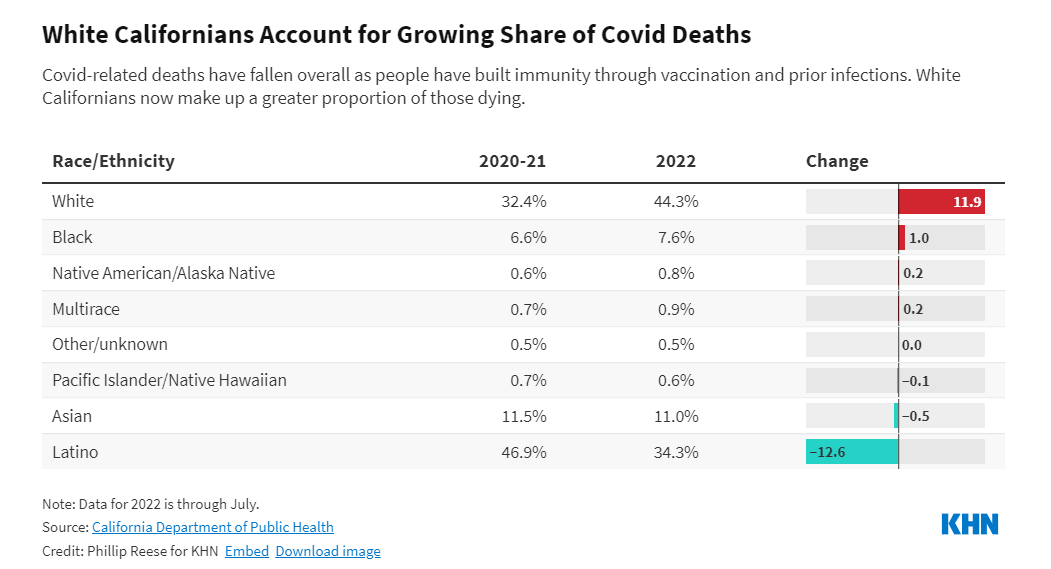
The decline in deaths was particularly striking among California’s Latino population.
In 2020 and 2021, Latino residents accounted for 47% of covid deaths in California — about 35,400 deaths — although they make up 40% of the state’s population. By comparison, Latinos accounted for 34% of covid deaths from January through July 2022, according to state data. That translates to about 4,600 deaths. Conversely, the proportion of covid deaths involving white residents increased from 32% in the first two years of the pandemic to 44% in the first seven months of 2022. That equates to 24,400 deaths involving white residents in 2020-21 and about 6,000 deaths in the first seven months of 2022. White people make up about 35% of the state’s population.
Researchers point to several factors in the shift. During the first two years of the pandemic, large numbers of the workers deemed essential, who continued to report to job sites in person, were Latino, while white residents were more likely to be employed in occupations that allowed them to work from home, U.S. Census Bureau surveys show. “They just got exposed more,” said Dr. George Rutherford, a professor of epidemiology and biostatistics at the University of California-San Francisco. “They're doing essential jobs and had to leave the house and go to work.” An imbalance in remote work remains, census data shows, but today the large majority of both Latino and white workers in California are reporting to work in person.
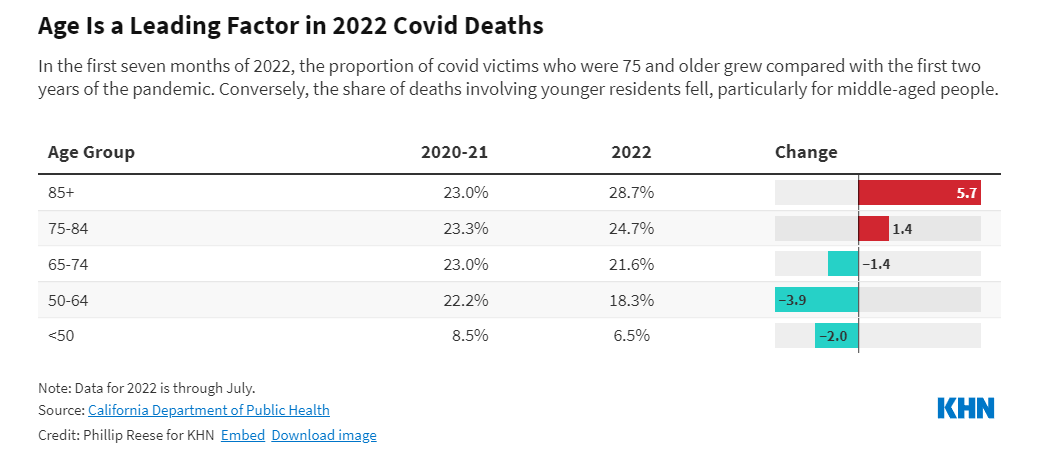
Californians age 75 and older made up 53% of covid deaths through July in 2022, up from 46% in 2020 and 2021. Only about 6% of the state’s residents are 75 and older. And white Californians 75 and older outnumber Latinos in that age group about 3 to 1. In the initial vaccination rollout, California prioritized seniors, first responders, and other essential workers, and for several months in 2021 older residents were much more likely to be vaccinated than younger Californians.
“Now, the vaccination rates have caught up pretty much with everybody except for kids, people under 18,” Brewer said. “You're seeing it go back to what we saw before, which is that age remains the most important risk factor for death.” More than 86% of Californians age 65 and older have completed their primary covid shot series. But the protection afforded by vaccines wanes over time, and since many seniors got their shots early, enough time passed between their second shot and the omicron wave of early 2022 to leave them vulnerable. About one-third of Californians 65 and older had not received a booster by early 2022, when the omicron wave peaked, and about one-quarter still haven’t received a booster.
snip
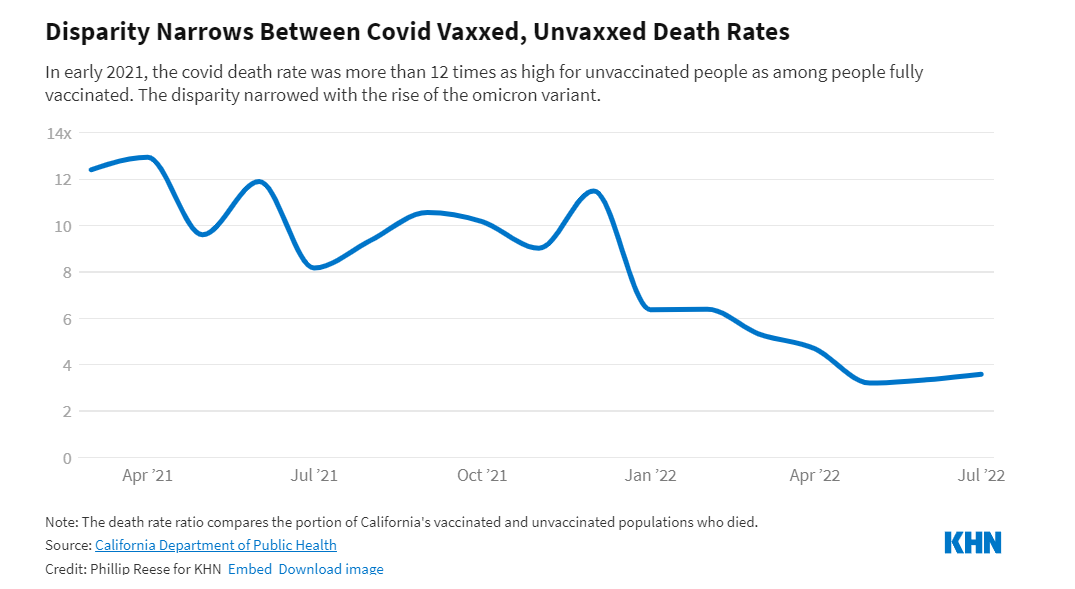
Covid Still Kills, but the Demographics of Its Victims Are Shifting
https://khn.org/news/article/covid-still-kills-but-the-demographics-of-its-victims-are-shifting/
The decline in deaths was particularly striking among California’s Latino population.
In 2020 and 2021, Latino residents accounted for 47% of covid deaths in California — about 35,400 deaths — although they make up 40% of the state’s population. By comparison, Latinos accounted for 34% of covid deaths from January through July 2022, according to state data. That translates to about 4,600 deaths. Conversely, the proportion of covid deaths involving white residents increased from 32% in the first two years of the pandemic to 44% in the first seven months of 2022. That equates to 24,400 deaths involving white residents in 2020-21 and about 6,000 deaths in the first seven months of 2022. White people make up about 35% of the state’s population.
Researchers point to several factors in the shift. During the first two years of the pandemic, large numbers of the workers deemed essential, who continued to report to job sites in person, were Latino, while white residents were more likely to be employed in occupations that allowed them to work from home, U.S. Census Bureau surveys show. “They just got exposed more,” said Dr. George Rutherford, a professor of epidemiology and biostatistics at the University of California-San Francisco. “They're doing essential jobs and had to leave the house and go to work.” An imbalance in remote work remains, census data shows, but today the large majority of both Latino and white workers in California are reporting to work in person.

Californians age 75 and older made up 53% of covid deaths through July in 2022, up from 46% in 2020 and 2021. Only about 6% of the state’s residents are 75 and older. And white Californians 75 and older outnumber Latinos in that age group about 3 to 1. In the initial vaccination rollout, California prioritized seniors, first responders, and other essential workers, and for several months in 2021 older residents were much more likely to be vaccinated than younger Californians.
“Now, the vaccination rates have caught up pretty much with everybody except for kids, people under 18,” Brewer said. “You're seeing it go back to what we saw before, which is that age remains the most important risk factor for death.” More than 86% of Californians age 65 and older have completed their primary covid shot series. But the protection afforded by vaccines wanes over time, and since many seniors got their shots early, enough time passed between their second shot and the omicron wave of early 2022 to leave them vulnerable. About one-third of Californians 65 and older had not received a booster by early 2022, when the omicron wave peaked, and about one-quarter still haven’t received a booster.
snip

September 24, 2022


https://globalextremism.org/reports/democracies-under-threat/

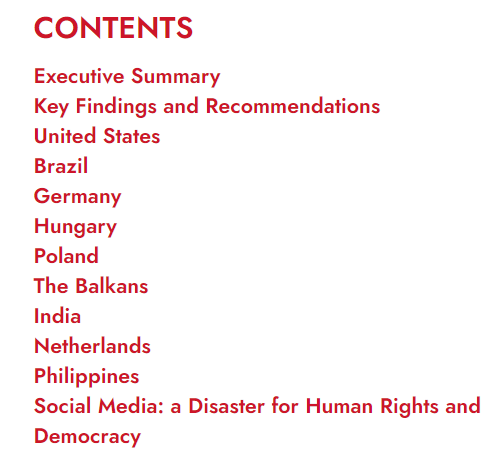
Executive Summary
The decision by multiple social media platforms to suspend or remove ex-American President Donald Trump after he incited a violent mob to invade the U.S. Capitol on January 6, 2021, was too little, too late. Even so, the deplatforming was important and it should become the standard for other political leaders and political parties around the world that have engaged in hate speech, disinformation, conspiracy-mongering and generally spreading extremist material that results in real world damage to democracies.
For years, Trump violated the community standards of several platforms with relative impunity. Tech leaders had made the affirmative decision to allow exceptions for the politically powerful, usually with the excuse of “newsworthiness” or under the guise of “political commentary” that the public supposedly needed to see. For example, last year Facebook decided to allow a Trump tweet targeting social justice protesters that read “when the looting starts, the shooting starts.” The tweet was cross-posted to Facebook and remained on the platform (Twitter took it down). Within days, the post had been shared over 71,000 times and reacted to over 253,000 times. The message was also overlaid onto a photo shared on Trump’s Instagram account, which quickly received over half a million likes.
Why did Trump’s clearly violative post stay up? Facebook CEO Mark Zuckerberg made the decision, though it was one criticized by many of his employees. “I disagree strongly with how the President spoke about this, but I believe people should be able to see this for themselves, because ultimately accountability for those in positions of power can only happen when their speech is scrutinized out in the open,” was Zuckerberg’s explanation.
Facebook in particular gives considerable latitude to public figures, codifying in its policies an exception that allows speech by political figures that violate its rules to stay up and prevents political ads from being fact-checked. The policy was created during the 2016 campaign specifically to allow hate and violative material posted by Trump to stay up. In the last year, Twitter, which has long allowed unfettered discourse, rethought its position stating that Trump will not be allowed back on the platform and began to sanction other political figures and political parties in the same way it deals with ordinary citizens. However, this change has not been wholesale and much violative content remains.
snip
The Full Report:
https://globalextremism.org/wp-content/uploads/2022/01/GPAHE_Democracy-under-threat.pdf
SPECIAL REPORT: How Loopholes for Trumps Social Media Enabled The Global Rise of Far-Right Extremism


https://globalextremism.org/reports/democracies-under-threat/


Executive Summary
The decision by multiple social media platforms to suspend or remove ex-American President Donald Trump after he incited a violent mob to invade the U.S. Capitol on January 6, 2021, was too little, too late. Even so, the deplatforming was important and it should become the standard for other political leaders and political parties around the world that have engaged in hate speech, disinformation, conspiracy-mongering and generally spreading extremist material that results in real world damage to democracies.
For years, Trump violated the community standards of several platforms with relative impunity. Tech leaders had made the affirmative decision to allow exceptions for the politically powerful, usually with the excuse of “newsworthiness” or under the guise of “political commentary” that the public supposedly needed to see. For example, last year Facebook decided to allow a Trump tweet targeting social justice protesters that read “when the looting starts, the shooting starts.” The tweet was cross-posted to Facebook and remained on the platform (Twitter took it down). Within days, the post had been shared over 71,000 times and reacted to over 253,000 times. The message was also overlaid onto a photo shared on Trump’s Instagram account, which quickly received over half a million likes.
Why did Trump’s clearly violative post stay up? Facebook CEO Mark Zuckerberg made the decision, though it was one criticized by many of his employees. “I disagree strongly with how the President spoke about this, but I believe people should be able to see this for themselves, because ultimately accountability for those in positions of power can only happen when their speech is scrutinized out in the open,” was Zuckerberg’s explanation.
Facebook in particular gives considerable latitude to public figures, codifying in its policies an exception that allows speech by political figures that violate its rules to stay up and prevents political ads from being fact-checked. The policy was created during the 2016 campaign specifically to allow hate and violative material posted by Trump to stay up. In the last year, Twitter, which has long allowed unfettered discourse, rethought its position stating that Trump will not be allowed back on the platform and began to sanction other political figures and political parties in the same way it deals with ordinary citizens. However, this change has not been wholesale and much violative content remains.
snip
The Full Report:
https://globalextremism.org/wp-content/uploads/2022/01/GPAHE_Democracy-under-threat.pdf
September 24, 2022

Donald Trump may have his accounts reinstated on Facebook next year following a review of the company’s decision to suspend him, a top executive for parent Meta Platforms said on Thursday.
Nick Clegg, president of global affairs for Meta, said at an event in Washington, D.C. that the company would consult with experts and weigh the impact. Clegg made the comments at an event for Semafor, the upcoming media startup.
“When you make a decision that affects the public realm, you need to act with great caution. You shouldn’t throw your weight about,” Clegg told Semafor’s Steve Clemons.
Facebook banned Trump from the platform indefinitely following the attack on the Capitol on Jan. 6, 2021. Facebook’s Oversight Board later said that it was “not appropriate” of the company to suspend Trump without a fixed time frame, and instructed Facebook to review the decision “and respond in a way that is clear and proportionate,” Clegg wrote at the time. Facebook then suspended Trump for a period of two years, lasting until Jan. 7, 2023. Beyond that date, Clegg wrote that Facebook would “evaluate external factors, including instances of violence, restrictions on peaceful assembly and other markers of civil unrest.”
snip
Meta Executive Says Donald Trump May Be Allowed Back On Facebook Following Review
https://deadline.com/2022/09/donald-trump-facebook-suspension-meta-1235124696/
Donald Trump may have his accounts reinstated on Facebook next year following a review of the company’s decision to suspend him, a top executive for parent Meta Platforms said on Thursday.
Nick Clegg, president of global affairs for Meta, said at an event in Washington, D.C. that the company would consult with experts and weigh the impact. Clegg made the comments at an event for Semafor, the upcoming media startup.
“When you make a decision that affects the public realm, you need to act with great caution. You shouldn’t throw your weight about,” Clegg told Semafor’s Steve Clemons.
Facebook banned Trump from the platform indefinitely following the attack on the Capitol on Jan. 6, 2021. Facebook’s Oversight Board later said that it was “not appropriate” of the company to suspend Trump without a fixed time frame, and instructed Facebook to review the decision “and respond in a way that is clear and proportionate,” Clegg wrote at the time. Facebook then suspended Trump for a period of two years, lasting until Jan. 7, 2023. Beyond that date, Clegg wrote that Facebook would “evaluate external factors, including instances of violence, restrictions on peaceful assembly and other markers of civil unrest.”
snip
September 24, 2022
some background:
The Latino population is drifting more and more to the RW as so many are going fundie evangelical that they are now the fastest growing ethnic group for evangelicals, and these converts are far more conservative and likely to vote Rethug.
For the first time ever, less than half of US Hispanics are now Catholic, the first ever for any large Hispanic population on the planet. Let that sink in.
In 2014, 11% of US evangelicals were Latino. 2 or 3 years ago it was up to 19%. Likely easily over 20% now. Thousands of small evangelical seed churches are being systematically set up by Latinos. The whole thing is being driven by the younger cohorts, not a bunch of ageing Boomers who are deciding to go hardcore con in religion and politics.
The Fastest-Growing Group of American Evangelicals
A new generation of Latino Protestants is poised to transform our religious and political landscapes.
https://www.theatlantic.com/culture/archive/2021/07/latinos-will-determine-future-american-evangelicalism/619551/
https://archive.ph/O3tMa

In 2007, when Obe and Jacqueline Arellano were in their mid-20s, they moved from the suburbs of Chicago to Aurora, Illinois, with the dream of starting a church. They chose Aurora, a midsize city with about 200,000 residents, mostly because about 40 percent of its population is Latino. Obe, a first-generation Mexican American pastor, told me, “We sensed God wanted us there.” By 2010, the couple had “planted a church,” the Protestant term for starting a brand-new congregation. This summer, the Arellanos moved to Long Beach, California, to pastor at Light & Life Christian Fellowship, which has planted 20 churches in 20 years. Their story is at once singular and representative of national trends: Across the United States, more Latino pastors are founding churches than ever before, a trend that challenges conventional views of evangelicalism and could have massive implications for the future of American politics.
Latinos are leaving the Catholic Church and converting to evangelical Protestantism in increased numbers, and evangelical organizations are putting more energy and resources toward reaching potential Latino congregants. Latinos are the fastest-growing group of evangelicals in the country, and Latino Protestants, in particular, have higher levels of religiosity—meaning they tend to go to church, pray, and read the Bible more often than both Anglo Protestants and Latino Catholics, according to Mark Mulder, a sociology professor at Calvin University and a co-author of Latino Protestants in America. At the same time, a major demographic shift is under way. Arellano, who supports Light & Life’s Spanish-speaking campus, Luz y Vida, told me, “By 2060, the Hispanic population in the United States is expected to grow from 60 million to over 110 million.” None of this is lost on either Latino or Anglo evangelical leadership: They know they need to recruit and train Latino pastors if they’re going to achieve what Arellano describes as “our vision to see that the kingdom of God will go forward and reach more people and get into every nook and cranny of society.”
The stakes of intensified Latino evangelicalism are manifold, and they depend on what kind of evangelicalism prevails across the country. The term evangelical has become synonymous with a voting bloc of Anglo cultural conservatives, but in general theological terms, evangelicals are Christians who believe in the supremacy of the Bible and that they are compelled to spread its gospel. Some Christians who identify with the theological definition fit the political stereotype, but others don’t. That’s true among evangelical Latino leaders too—they have very different interpretations of how the teachings of Jesus Christ call them to act. Every pastor I spoke with told me that they want to see more Latino pastors in leadership positions, and they each had a different take on what new Latino leadership could mean for the future of evangelicalism. When we spoke over the phone, Samuel Rodriguez, the president of the National Hispanic Christian Leadership Conference and the pastor of New Season Worship, in Sacramento, California, told me, “We’re not extending our hand out, asking, ‘Can you help us plant churches?’ We’re coming to primarily white denominations and going, ‘You all need our help.’ This is a flipping of the script.”
Although Latino congregations are too diverse to characterize in shorthand, one of the few declarative statements that can be made about Latino Protestants is a fact borne out with numbers: They are likelier than Latino Catholics to vote Republican. The expansion of Latino evangelicalism bucks assumptions that Democrats and progressives will soon have a clear advantage as the white church declines and the Hispanic electorate rises. “Some counterintuitive things that have happened [in our national politics] would make more sense if we better understood the faith communities that exist within Latinx Protestantism,” Mulder told me over the phone, alluding to the differing perspectives Latinos hold on many issues, including immigration, and how more Latinos voted for former President Donald Trump in 2020 than in 2016. According to the Public Religion Research Institute, Protestant affiliation correlated more with Hispanic approval of Trump’s job in office than age or gender.
snip
excellent longform article, much more at the top link
There is a link in the article that references the Religious Landscape Study by Pew
in 2014 11% of evangelicals were Latino.
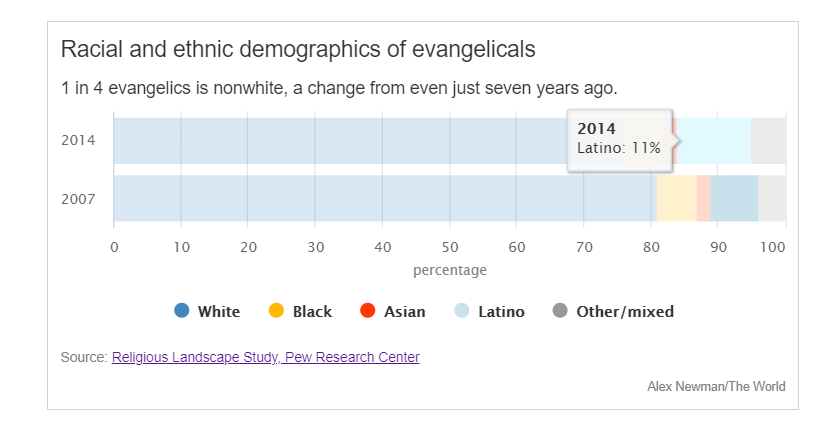
Now, the latest numbers from Pew show it is up to 19% (in less that 7 years)
It is likely over 20% now and growing rapidly, driven by the younger gens,
less than half of Latinos in the US are now Catholic, which is pretty amazing
https://www.pewforum.org/religious-landscape-study/racial-and-ethnic-composition/latino/
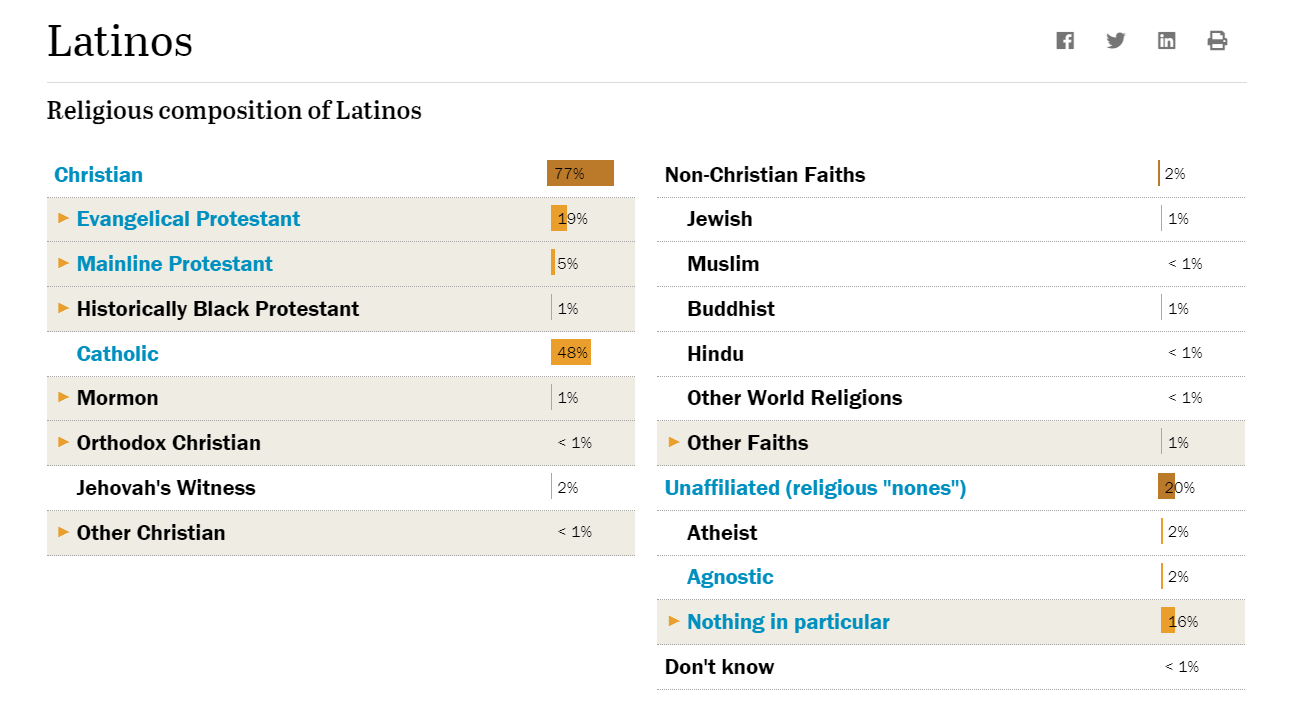
also, there is this:
The Newest Texans Are Not Who You Think They Are
The record influx of recent arrivals from all over might be exactly what the state needs. That includes Californians. (And no, they’re not turning Texas blue.)
https://www.texasmonthly.com/news-politics/newest-texans-who-are-they/

snip
Whatever their ethnicities, Californians are coming to Texas in much higher numbers than are migrants from any other state. In 2019 about 42 percent of net domestic immigrants came from California. For all the hyperventilating about Californians ruining certain Texas cities, however, the fastest-growing parts of the state owe much of their growth to Texans shuffling around from city to city. In fact, a primary reason Texas is growing so fast is that we tend to stick around as compared to natives of other states, meaning there’s less out-migration to offset the in-migration. About 82 percent of people born in Texas still live here, making it the so-called stickiest state in the country.
Bill Fulton, director of the Kinder Institute for Urban Research at Rice University, in Houston, points out that “basically all the population growth is in the Texas Triangle,” the relatively tight space defined by the Dallas–Fort Worth, Houston, and Austin–San Antonio regions. He recently wrote a book with former San Antonio mayor Henry Cisneros, “and we found that the Texas Triangle favorably compared to virtually all other mega-regions in the U.S., including Southern California and the Northeast Corridor. It is a true economic powerhouse.”
That’s just one of the ways Texas’s population growth is changing the landscape. In the booming cities, Fulton points out, the influx of a young professional class has led to a flowering of high-rise and mid-rise apartment buildings, as well as multiunit home lots. At the same time, suburbs have become more diverse than they were in the days of white flight from urban neighborhoods, in the sixties, in part because today gentrifying city neighborhoods are edging out non-white residents. Rural and small-town Texas, meanwhile, is shrinking. In fact, 142 of the state’s 254 counties are declining in population, some of them precipitously. Schleicher County, between San Angelo and Sonora, lost 29 percent of its population in ten years, the steepest drop in the state.
The diversification of the suburbs could fundamentally alter the political map by changing reliable Republican standbys to perennial toss-ups. Dying small towns carry less electoral weight. Gerrymandering of districts, now pursued as avidly by Republicans as it once was by Democrats, will continue to redraw electoral maps to maintain the current political order. But at some point, likely soon, the old assumptions will simply no longer hold true, and the keys to winning Texas will change.



The Democrats' Hispanic Voter Problem: It's Not As Bad As You Think--It's Worse
https://theliberalpatriot.substack.com/p/the-democrats-hispanic-voter-problem-dfc
By Ruy Teixeira (Center for American Progress, Brookings Institution, etc)
The Democrats are steadily losing ground with Hispanic voters. The seriousness of this problem tends to be underestimated in Democratic circles for a couple of reasons: (1) they don’t realize how big the shift is; and (2) they don’t realize how thoroughly it undermines the most influential Democratic theory of the case for building their coalition. On the latter, consider that most Democrats like to believe that, since a relatively conservative white population is in sharp decline while a presumably liberal nonwhite population keeps growing, the course of social and demographic change should deliver an ever-growing Democratic coalition. It is simply a matter of getting this burgeoning nonwhite population to the polls.
But consider further that, as the Census documents, the biggest single driver of the increased nonwhite population is the growth of the Hispanic population. They are by far the largest group within the Census-designated nonwhite population (19 percent vs. 12 percent for blacks). While their representation among voters considerably lags their representation in the overall population, it is fair to say that voting trends among this group will decisively shape voting trends among nonwhites in the future since their share of voters will continue to increase while black voter share is expected to remain roughly constant.
It therefore follows that, if Hispanic voting trends continue to move steadily against the Democrats, the pro-Democratic effect of nonwhite population growth will be blunted, if not cancelled out entirely, and that very influential Democratic theory of the case falls apart. That could—or should—provoke quite a sea change in Democratic thinking. Turning to the nature and size of recent Hispanic shifts against the Democrats—it’s not as bad as you think, it’s worse. Here are ten points drawn from available data about the views and voting behavior of this population. Read ‘em and weep.
1. In the most recent Wall Street Journal poll, Hispanic voters were split evenly between Democrats and Republicans in the 2022 generic Congressional ballot. And in a 2024 hypothetical rematch between Trump and Biden, these voters favored Biden by only a single point. This is among a voter group that favored Biden over Trump in 2020 by 26 points according to Catalist (two party vote).
snip
much, much more at the link, a tonne of data, this is not just one poll
vital show now (10pm EST) on MSNBC about the rapid shifts to the Rethugs/RW by many Latinos
Field Report with Paola Ramos: South Texas 2022some background:
The Latino population is drifting more and more to the RW as so many are going fundie evangelical that they are now the fastest growing ethnic group for evangelicals, and these converts are far more conservative and likely to vote Rethug.
For the first time ever, less than half of US Hispanics are now Catholic, the first ever for any large Hispanic population on the planet. Let that sink in.
In 2014, 11% of US evangelicals were Latino. 2 or 3 years ago it was up to 19%. Likely easily over 20% now. Thousands of small evangelical seed churches are being systematically set up by Latinos. The whole thing is being driven by the younger cohorts, not a bunch of ageing Boomers who are deciding to go hardcore con in religion and politics.
The Fastest-Growing Group of American Evangelicals
A new generation of Latino Protestants is poised to transform our religious and political landscapes.
https://www.theatlantic.com/culture/archive/2021/07/latinos-will-determine-future-american-evangelicalism/619551/
https://archive.ph/O3tMa

In 2007, when Obe and Jacqueline Arellano were in their mid-20s, they moved from the suburbs of Chicago to Aurora, Illinois, with the dream of starting a church. They chose Aurora, a midsize city with about 200,000 residents, mostly because about 40 percent of its population is Latino. Obe, a first-generation Mexican American pastor, told me, “We sensed God wanted us there.” By 2010, the couple had “planted a church,” the Protestant term for starting a brand-new congregation. This summer, the Arellanos moved to Long Beach, California, to pastor at Light & Life Christian Fellowship, which has planted 20 churches in 20 years. Their story is at once singular and representative of national trends: Across the United States, more Latino pastors are founding churches than ever before, a trend that challenges conventional views of evangelicalism and could have massive implications for the future of American politics.
Latinos are leaving the Catholic Church and converting to evangelical Protestantism in increased numbers, and evangelical organizations are putting more energy and resources toward reaching potential Latino congregants. Latinos are the fastest-growing group of evangelicals in the country, and Latino Protestants, in particular, have higher levels of religiosity—meaning they tend to go to church, pray, and read the Bible more often than both Anglo Protestants and Latino Catholics, according to Mark Mulder, a sociology professor at Calvin University and a co-author of Latino Protestants in America. At the same time, a major demographic shift is under way. Arellano, who supports Light & Life’s Spanish-speaking campus, Luz y Vida, told me, “By 2060, the Hispanic population in the United States is expected to grow from 60 million to over 110 million.” None of this is lost on either Latino or Anglo evangelical leadership: They know they need to recruit and train Latino pastors if they’re going to achieve what Arellano describes as “our vision to see that the kingdom of God will go forward and reach more people and get into every nook and cranny of society.”
The stakes of intensified Latino evangelicalism are manifold, and they depend on what kind of evangelicalism prevails across the country. The term evangelical has become synonymous with a voting bloc of Anglo cultural conservatives, but in general theological terms, evangelicals are Christians who believe in the supremacy of the Bible and that they are compelled to spread its gospel. Some Christians who identify with the theological definition fit the political stereotype, but others don’t. That’s true among evangelical Latino leaders too—they have very different interpretations of how the teachings of Jesus Christ call them to act. Every pastor I spoke with told me that they want to see more Latino pastors in leadership positions, and they each had a different take on what new Latino leadership could mean for the future of evangelicalism. When we spoke over the phone, Samuel Rodriguez, the president of the National Hispanic Christian Leadership Conference and the pastor of New Season Worship, in Sacramento, California, told me, “We’re not extending our hand out, asking, ‘Can you help us plant churches?’ We’re coming to primarily white denominations and going, ‘You all need our help.’ This is a flipping of the script.”
Although Latino congregations are too diverse to characterize in shorthand, one of the few declarative statements that can be made about Latino Protestants is a fact borne out with numbers: They are likelier than Latino Catholics to vote Republican. The expansion of Latino evangelicalism bucks assumptions that Democrats and progressives will soon have a clear advantage as the white church declines and the Hispanic electorate rises. “Some counterintuitive things that have happened [in our national politics] would make more sense if we better understood the faith communities that exist within Latinx Protestantism,” Mulder told me over the phone, alluding to the differing perspectives Latinos hold on many issues, including immigration, and how more Latinos voted for former President Donald Trump in 2020 than in 2016. According to the Public Religion Research Institute, Protestant affiliation correlated more with Hispanic approval of Trump’s job in office than age or gender.
snip
excellent longform article, much more at the top link
There is a link in the article that references the Religious Landscape Study by Pew
in 2014 11% of evangelicals were Latino.

Now, the latest numbers from Pew show it is up to 19% (in less that 7 years)
It is likely over 20% now and growing rapidly, driven by the younger gens,
less than half of Latinos in the US are now Catholic, which is pretty amazing
https://www.pewforum.org/religious-landscape-study/racial-and-ethnic-composition/latino/

also, there is this:
The Newest Texans Are Not Who You Think They Are
The record influx of recent arrivals from all over might be exactly what the state needs. That includes Californians. (And no, they’re not turning Texas blue.)
https://www.texasmonthly.com/news-politics/newest-texans-who-are-they/

snip
Whatever their ethnicities, Californians are coming to Texas in much higher numbers than are migrants from any other state. In 2019 about 42 percent of net domestic immigrants came from California. For all the hyperventilating about Californians ruining certain Texas cities, however, the fastest-growing parts of the state owe much of their growth to Texans shuffling around from city to city. In fact, a primary reason Texas is growing so fast is that we tend to stick around as compared to natives of other states, meaning there’s less out-migration to offset the in-migration. About 82 percent of people born in Texas still live here, making it the so-called stickiest state in the country.
Bill Fulton, director of the Kinder Institute for Urban Research at Rice University, in Houston, points out that “basically all the population growth is in the Texas Triangle,” the relatively tight space defined by the Dallas–Fort Worth, Houston, and Austin–San Antonio regions. He recently wrote a book with former San Antonio mayor Henry Cisneros, “and we found that the Texas Triangle favorably compared to virtually all other mega-regions in the U.S., including Southern California and the Northeast Corridor. It is a true economic powerhouse.”
That’s just one of the ways Texas’s population growth is changing the landscape. In the booming cities, Fulton points out, the influx of a young professional class has led to a flowering of high-rise and mid-rise apartment buildings, as well as multiunit home lots. At the same time, suburbs have become more diverse than they were in the days of white flight from urban neighborhoods, in the sixties, in part because today gentrifying city neighborhoods are edging out non-white residents. Rural and small-town Texas, meanwhile, is shrinking. In fact, 142 of the state’s 254 counties are declining in population, some of them precipitously. Schleicher County, between San Angelo and Sonora, lost 29 percent of its population in ten years, the steepest drop in the state.
The diversification of the suburbs could fundamentally alter the political map by changing reliable Republican standbys to perennial toss-ups. Dying small towns carry less electoral weight. Gerrymandering of districts, now pursued as avidly by Republicans as it once was by Democrats, will continue to redraw electoral maps to maintain the current political order. But at some point, likely soon, the old assumptions will simply no longer hold true, and the keys to winning Texas will change.



The Democrats' Hispanic Voter Problem: It's Not As Bad As You Think--It's Worse
https://theliberalpatriot.substack.com/p/the-democrats-hispanic-voter-problem-dfc
By Ruy Teixeira (Center for American Progress, Brookings Institution, etc)
The Democrats are steadily losing ground with Hispanic voters. The seriousness of this problem tends to be underestimated in Democratic circles for a couple of reasons: (1) they don’t realize how big the shift is; and (2) they don’t realize how thoroughly it undermines the most influential Democratic theory of the case for building their coalition. On the latter, consider that most Democrats like to believe that, since a relatively conservative white population is in sharp decline while a presumably liberal nonwhite population keeps growing, the course of social and demographic change should deliver an ever-growing Democratic coalition. It is simply a matter of getting this burgeoning nonwhite population to the polls.
But consider further that, as the Census documents, the biggest single driver of the increased nonwhite population is the growth of the Hispanic population. They are by far the largest group within the Census-designated nonwhite population (19 percent vs. 12 percent for blacks). While their representation among voters considerably lags their representation in the overall population, it is fair to say that voting trends among this group will decisively shape voting trends among nonwhites in the future since their share of voters will continue to increase while black voter share is expected to remain roughly constant.
It therefore follows that, if Hispanic voting trends continue to move steadily against the Democrats, the pro-Democratic effect of nonwhite population growth will be blunted, if not cancelled out entirely, and that very influential Democratic theory of the case falls apart. That could—or should—provoke quite a sea change in Democratic thinking. Turning to the nature and size of recent Hispanic shifts against the Democrats—it’s not as bad as you think, it’s worse. Here are ten points drawn from available data about the views and voting behavior of this population. Read ‘em and weep.
1. In the most recent Wall Street Journal poll, Hispanic voters were split evenly between Democrats and Republicans in the 2022 generic Congressional ballot. And in a 2024 hypothetical rematch between Trump and Biden, these voters favored Biden by only a single point. This is among a voter group that favored Biden over Trump in 2020 by 26 points according to Catalist (two party vote).
snip
much, much more at the link, a tonne of data, this is not just one poll
September 24, 2022
https://www.bbc.com/news/newsbeat-63010712
After three years without a solo release - Stormzy dropped his new single Mel Made me Do It with a powerful, 10-minute music video on Thursday night. It stars a range of black British icons, from Dave to Little Simz, as well Brenda Edwards, mother of late music producer Jamal. Cameos from sport, musical and cultural heroes have been called "a celebration of Black British excellence". The track has been an instant hit - racking up more than one million Youtube views in less than 24 hours. And many black British people have been heaping praise upon Stormzy's latest.
https://twitter.com/Habibakatsha/status/1573063750143328256
Afolabi spoke to BBC Newsbeat about his own reaction. "I still struggle to call myself a black Brit. I grew up here all my life and I have strong ties here, but I'm also Nigerian" says Afolabi. "There are times when this country will remind you that we're not wanted and it makes me glad that I'm Nigerian because I have a community that I can still relate to," says the 29-year-old. "However, Stormzy's video really made me proud to call myself a black Brit." Afolabi was particularly excited to see all the stars in the video - from talk show hosts to football managers. "Take Ian Wright as an example," he says. "He's a legend that faced adversity and got into professional football at a late age and still succeeded."
Afolabi also names Jenny Francis - who "provided joy for so many of us" - and Noughts and Crosses author Malorie Blackman as personally significant appearances. In the music video Malorie walks alongside another author, Jade LB, who wrote the award winning book - Keisha the Sket. Jade told Newsbeat last year that she's an "advocate" for telling stories from "marginalised communities". "These people and so many more played a part in shaping me and our struggles and our joy are similar in one way or another and that for me is what truly makes us black British," says Afolabi.
The track is named after Melissa Holdbrook-Akposoe, better know as influencer Melissa's Wardrobe - Stormzy's stylist and CEO of It's a Lifestyle Hun. Her impact has been highlighted on social media as well. "Understanding Melissa's influence is not a surprise to me. I'm an invested fan so I was aware for a long time and has been aware of her affiliation with Big Mike," says Afolabi. "When Stormzy was on Instagram, she was always on the stories and look at the amazing job she did for him at The Met Gala. The core of us have known of Melissa and her influence for a long time, the mainstream are just catching up." Both Stormzy and Melissa are now in Ghana ahead of the Global Citizen concert in the country's capital Accra.
snip
'Stormzy has gone clear': Video featuring Jose Mourinho, Usain Bolt and Louis Theroux prompts rapturous response
Stormzy has sparked a rapturous response online with the surprise release of a new 11-minute music video featuring a plethora of cameos including Usain Bolt, Jose Mourinho and Louis Theroux.
https://news.sky.com/story/stormzy-has-gone-clear-video-featuring-jose-mourinho-usain-bolt-and-louis-theroux-prompts-rapturous-response-12703736

Mel Made Me Do It is the rapper's first solo effort in nearly three years and its sharp, twisting rhymes put his songwriting prowess and delivery on full show.
Including no chorus or hook, the surprise release on Thursday night triggered an instant outpouring of acclaim online and racked up more than half a million views on YouTube within hours.

Stormzy, Louis Theroux and Dina Asher-Smith
Much of the initial excitement on social media focused on the appearance of Mourinho - and reference to the popular meme of the football manager's "if I speak I am in big trouble" comment.
But there was also widespread praise for cameos from an array of pioneers of Black British culture, including Gabrielle, Ian Wright, Jazzie B, Malorie Blackman, Trevor Nelson, Dave, JME and a tribute to late SBTV founder Jamal Edwards.
https://twitter.com/TobiRachel_/status/1573218609438261248
https://twitter.com/nattykasambala/status/1573064515801194496
https://twitter.com/MayowaQuadri_/status/1573079400727384064
Stormzy: Mel Made Me Do It 'celebrates black British excellence' ❤️💚🖤💛
https://www.bbc.com/news/newsbeat-63010712
After three years without a solo release - Stormzy dropped his new single Mel Made me Do It with a powerful, 10-minute music video on Thursday night. It stars a range of black British icons, from Dave to Little Simz, as well Brenda Edwards, mother of late music producer Jamal. Cameos from sport, musical and cultural heroes have been called "a celebration of Black British excellence". The track has been an instant hit - racking up more than one million Youtube views in less than 24 hours. And many black British people have been heaping praise upon Stormzy's latest.
https://twitter.com/Habibakatsha/status/1573063750143328256
Afolabi spoke to BBC Newsbeat about his own reaction. "I still struggle to call myself a black Brit. I grew up here all my life and I have strong ties here, but I'm also Nigerian" says Afolabi. "There are times when this country will remind you that we're not wanted and it makes me glad that I'm Nigerian because I have a community that I can still relate to," says the 29-year-old. "However, Stormzy's video really made me proud to call myself a black Brit." Afolabi was particularly excited to see all the stars in the video - from talk show hosts to football managers. "Take Ian Wright as an example," he says. "He's a legend that faced adversity and got into professional football at a late age and still succeeded."
Afolabi also names Jenny Francis - who "provided joy for so many of us" - and Noughts and Crosses author Malorie Blackman as personally significant appearances. In the music video Malorie walks alongside another author, Jade LB, who wrote the award winning book - Keisha the Sket. Jade told Newsbeat last year that she's an "advocate" for telling stories from "marginalised communities". "These people and so many more played a part in shaping me and our struggles and our joy are similar in one way or another and that for me is what truly makes us black British," says Afolabi.
The track is named after Melissa Holdbrook-Akposoe, better know as influencer Melissa's Wardrobe - Stormzy's stylist and CEO of It's a Lifestyle Hun. Her impact has been highlighted on social media as well. "Understanding Melissa's influence is not a surprise to me. I'm an invested fan so I was aware for a long time and has been aware of her affiliation with Big Mike," says Afolabi. "When Stormzy was on Instagram, she was always on the stories and look at the amazing job she did for him at The Met Gala. The core of us have known of Melissa and her influence for a long time, the mainstream are just catching up." Both Stormzy and Melissa are now in Ghana ahead of the Global Citizen concert in the country's capital Accra.
snip
'Stormzy has gone clear': Video featuring Jose Mourinho, Usain Bolt and Louis Theroux prompts rapturous response
Stormzy has sparked a rapturous response online with the surprise release of a new 11-minute music video featuring a plethora of cameos including Usain Bolt, Jose Mourinho and Louis Theroux.
https://news.sky.com/story/stormzy-has-gone-clear-video-featuring-jose-mourinho-usain-bolt-and-louis-theroux-prompts-rapturous-response-12703736

Mel Made Me Do It is the rapper's first solo effort in nearly three years and its sharp, twisting rhymes put his songwriting prowess and delivery on full show.
Including no chorus or hook, the surprise release on Thursday night triggered an instant outpouring of acclaim online and racked up more than half a million views on YouTube within hours.

Stormzy, Louis Theroux and Dina Asher-Smith
Much of the initial excitement on social media focused on the appearance of Mourinho - and reference to the popular meme of the football manager's "if I speak I am in big trouble" comment.
But there was also widespread praise for cameos from an array of pioneers of Black British culture, including Gabrielle, Ian Wright, Jazzie B, Malorie Blackman, Trevor Nelson, Dave, JME and a tribute to late SBTV founder Jamal Edwards.
https://twitter.com/TobiRachel_/status/1573218609438261248
https://twitter.com/nattykasambala/status/1573064515801194496
https://twitter.com/MayowaQuadri_/status/1573079400727384064
September 23, 2022
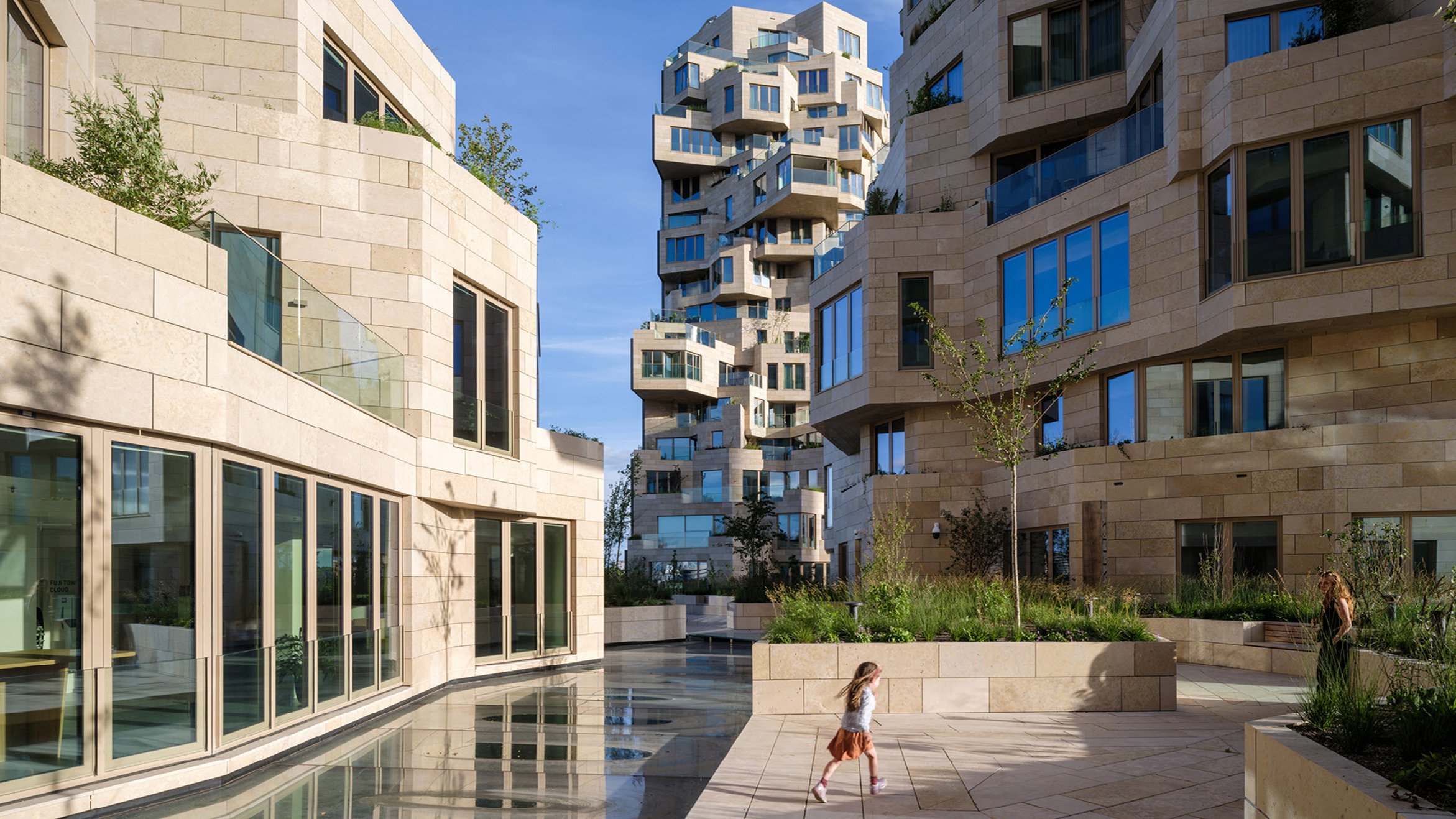
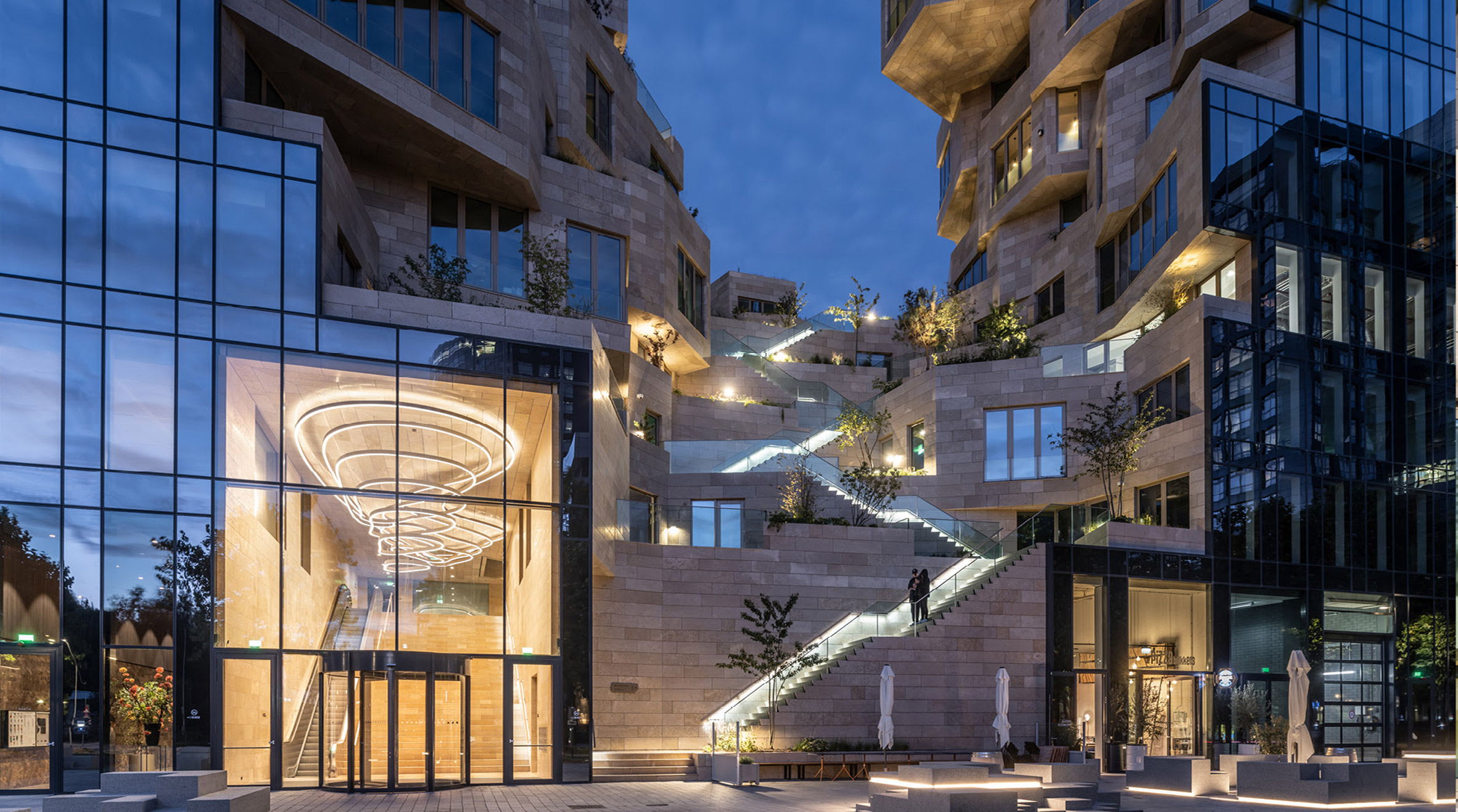
A mountain-like angular skyscraper with jagged peaks named Valley, which was designed by Dutch studio MVRDV, has officially opened in Amsterdam, the Netherlands. The 75,000-square-meter development in Amsterdam's Zuidas district was designed for real estate developer EDGE and contains 200 apartments along with offices and restaurants.
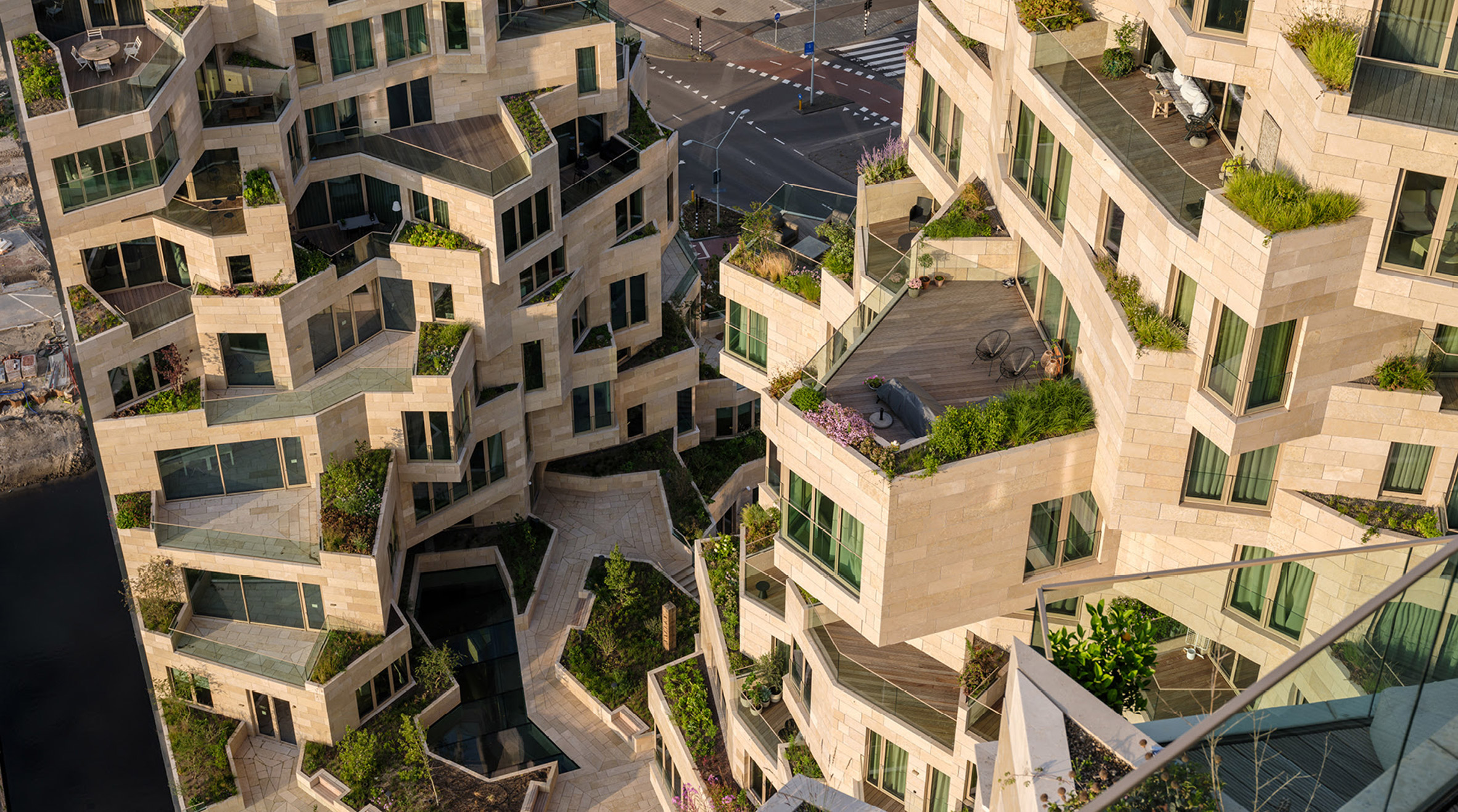
The 100-metre-high building was designed as a "symphony of life", according to MVRDV founding partner Winy Maas. "How do you make an office district liveable?" Maas said. "What should the homes be like? What else is needed? Those were the questions we started with when we designed Valley."
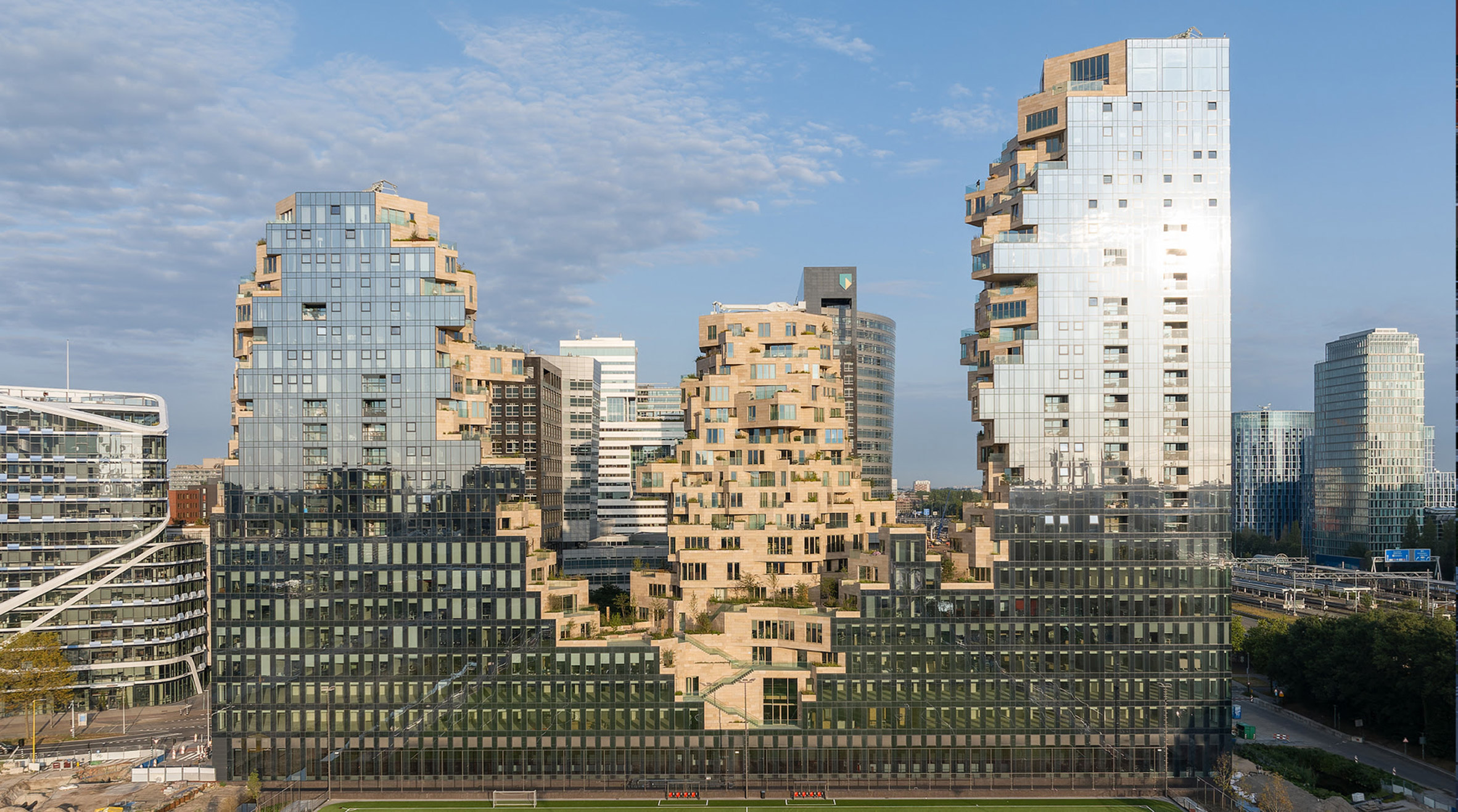
"Instead of a one-note business centre, this site along Beethovenstraat in Amsterdam is now a symphony of life – people working, yes, but also barbecuing on their terraces, visitors relaxing in the valley, shopping in the grotto, eating dinner by the street, and even the window cleaners and the gardeners scaling the heights above," he added. "Valley is a first step towards transforming this part of Amsterdam into a greener, denser, and more human city."
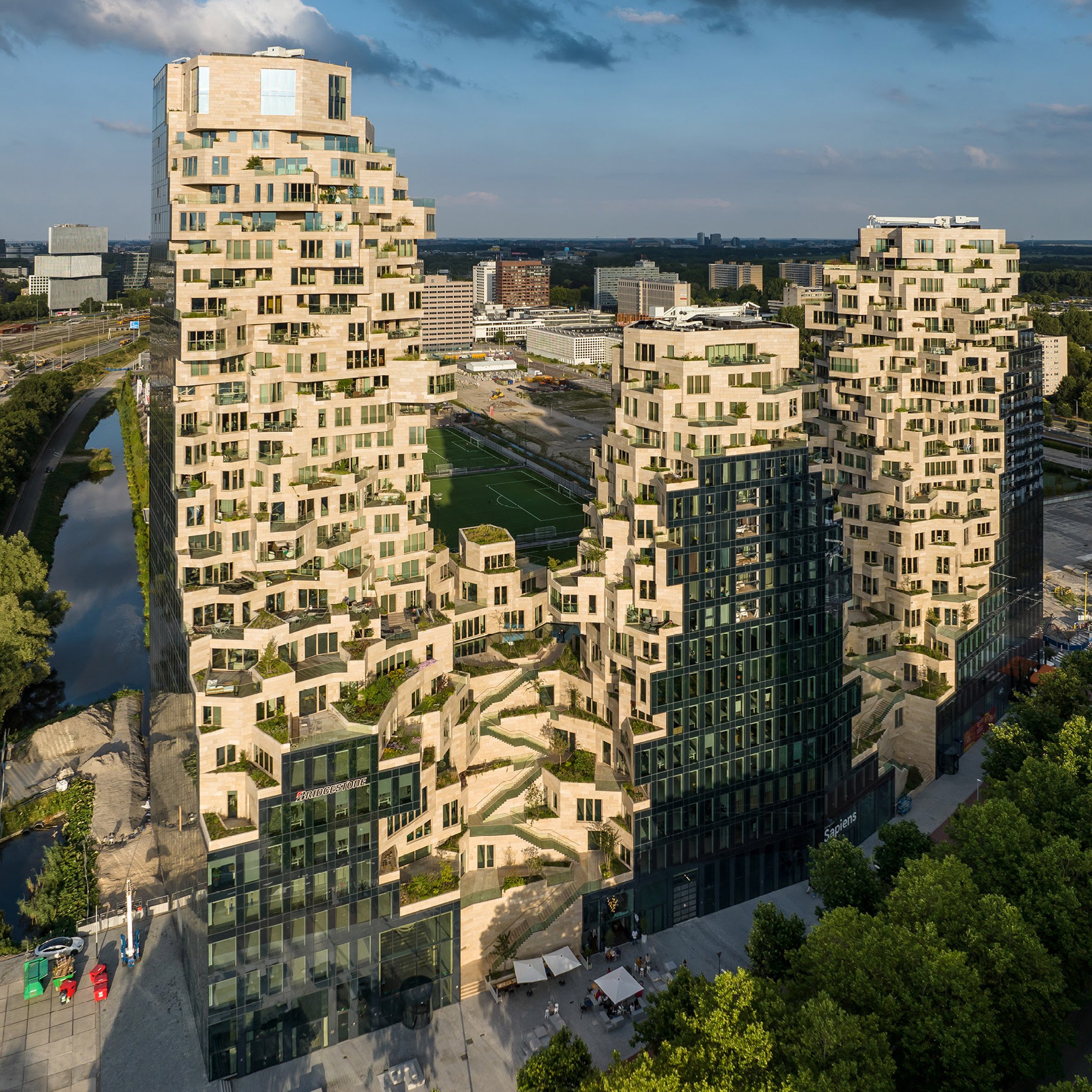
The high-rise is composed of three connected towers of different heights that rise from a podium structure. Each of the towers has a largerly glazed facade and a contrasting facade containing a multitude of terraces and balconies that overlap one another. Custom digital tools were used to make sure each apartment had enough light while creating a seemingly random pattern from the balconies, which were clad in 40,000 stone tiles.
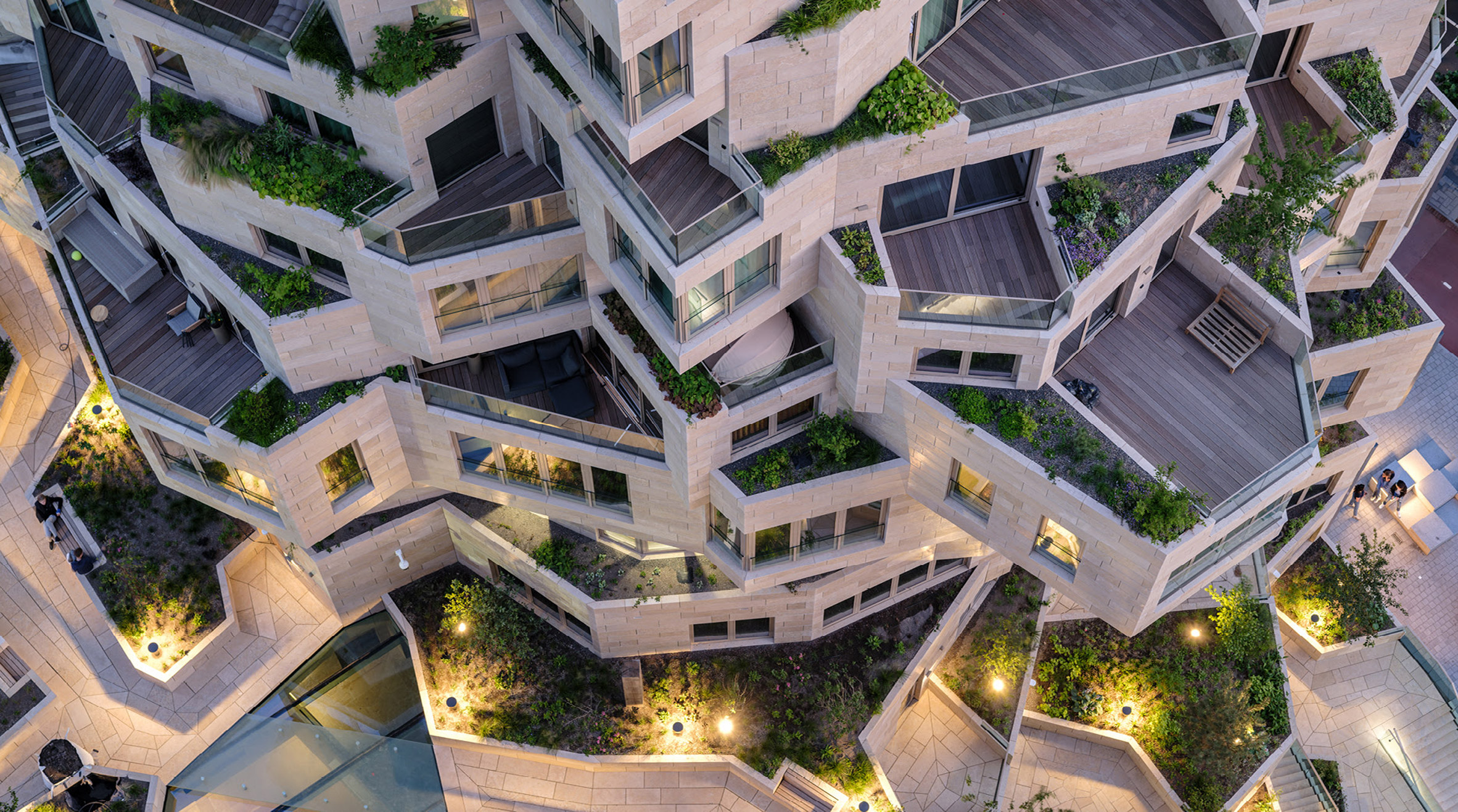
snip
MVRDV's angular Valley skyscraper opens in Amsterdam
https://www.dezeen.com/2022/09/20/valley-skyscraper-mvrdv-open-amsterdam/

A mountain-like angular skyscraper with jagged peaks named Valley, which was designed by Dutch studio MVRDV, has officially opened in Amsterdam, the Netherlands. The 75,000-square-meter development in Amsterdam's Zuidas district was designed for real estate developer EDGE and contains 200 apartments along with offices and restaurants.

The 100-metre-high building was designed as a "symphony of life", according to MVRDV founding partner Winy Maas. "How do you make an office district liveable?" Maas said. "What should the homes be like? What else is needed? Those were the questions we started with when we designed Valley."

"Instead of a one-note business centre, this site along Beethovenstraat in Amsterdam is now a symphony of life – people working, yes, but also barbecuing on their terraces, visitors relaxing in the valley, shopping in the grotto, eating dinner by the street, and even the window cleaners and the gardeners scaling the heights above," he added. "Valley is a first step towards transforming this part of Amsterdam into a greener, denser, and more human city."

The high-rise is composed of three connected towers of different heights that rise from a podium structure. Each of the towers has a largerly glazed facade and a contrasting facade containing a multitude of terraces and balconies that overlap one another. Custom digital tools were used to make sure each apartment had enough light while creating a seemingly random pattern from the balconies, which were clad in 40,000 stone tiles.

snip
Profile Information
Gender: FemaleHometown: London
Home country: US/UK/Sweden
Current location: Stockholm, Sweden
Member since: Sun Jul 1, 2018, 07:25 PM
Number of posts: 43,497